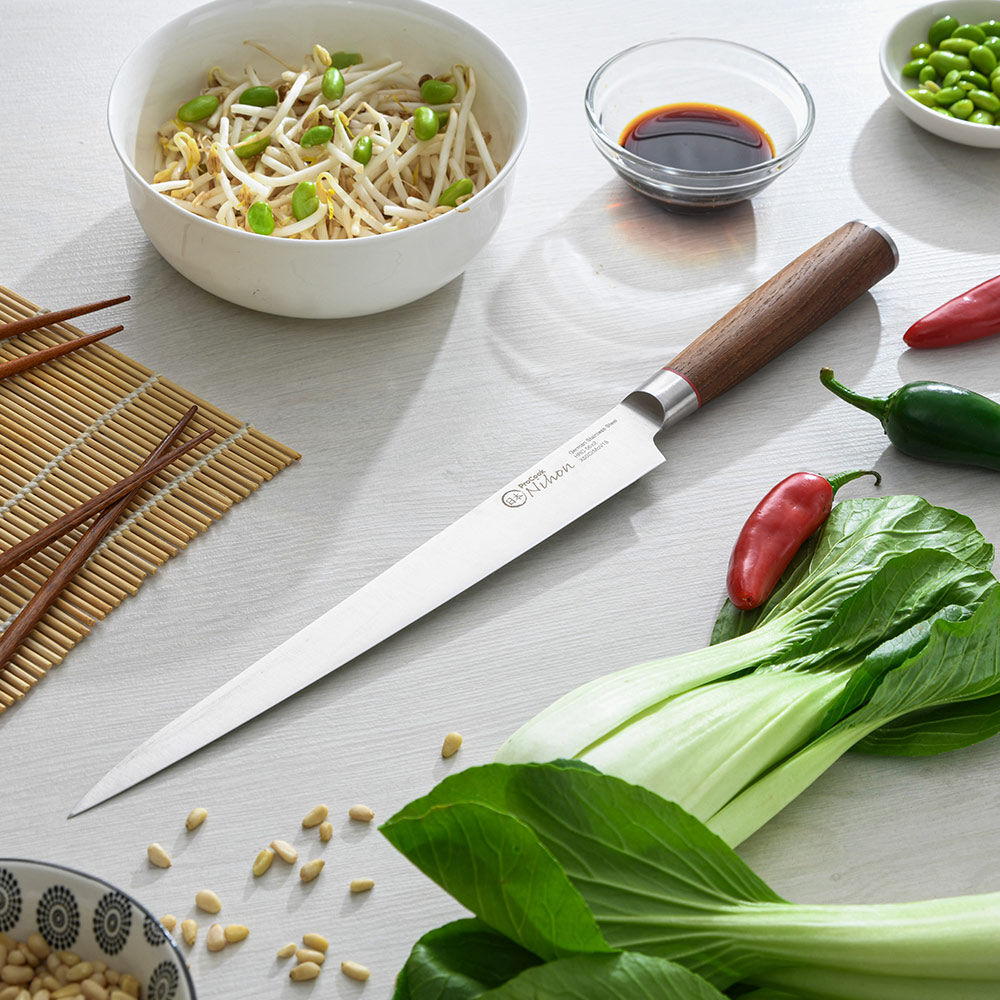ProCook Help Hub
The latest inspiration and advice from the experts at ProCook
You've treated yourself to a Japanese knife, but how do you care for one and is it any different to caring for your other, more standard kitchen knives? Japanese knives are renowned for being intricately crafted and having their own unique blade and edge that's shaper but also more brittle. Therefore, a Japanese knife requires special care and attention, so you can keep the blade sharp and useable for years to come.
Read on for our in-depth guide on how you can care for your Japanese knives and Japanese style knives.
Although Japanese knives are the standard knives used in Japan, they have become a popular choice of kitchen knife for professional chefs and amateur cooks across the world. When compared to Western knives, Japanese knives are generally more lightweight, feel more balanced when held, and feature a steel blade that is harder, thinner and holds an edge for longer. The blade of a Japanese knife is perfect for precise tasks like finely slicing and dicing food into thinner and more delicate ribbons and slices.
Japanese knives are typically synonymous with beautiful craftmanship. Traditional Japanese knives frequently include a wooden handle that's rounded, and if your blade is made from Damascus steel, your knife will feature a beloved wavy, mottled pattern. Many people love the look of Japanese knives, which is why Japanese style knives are popular throughout the world.
Our Japanese style knives are heavily inspired by traditional Japanese craftmanship, resulting in a set of knives that offer super-sharp cutting for precision tasks and a handle that offers perfect balance.
Why are Japanese Knives so Popular?
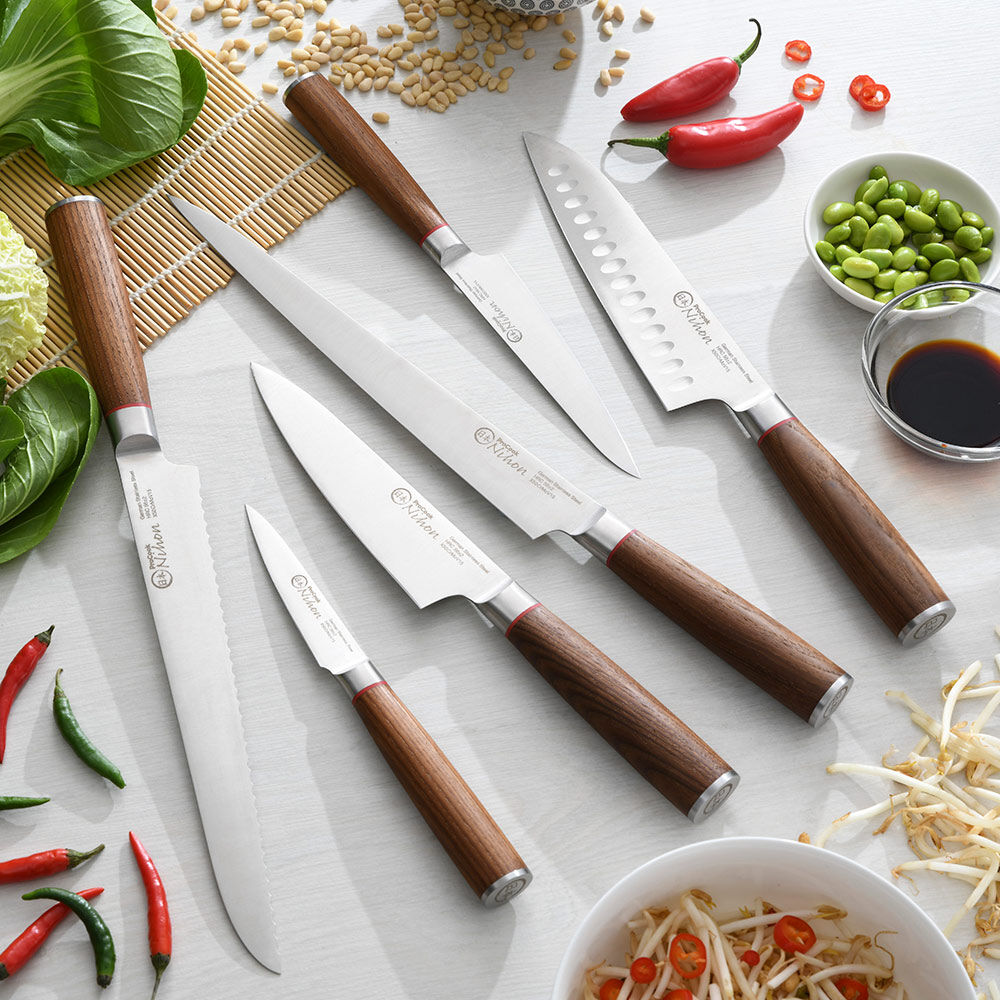
The Difference Between Japanese Knives and Western Knives
There are many differences between a Japanese knife and a Western knife (also known as a German or European knife). While both Japanese and Western knives are great ways to chop your ingredients, they each have their own benefits. Being aware of the differences can help you understand which knife suits your cooking style and how best to use a Japanese knife.
Both knives differ in appearance. A Western style knife features a more curved and thicker edge, making the blade much more robust. Western knives are also double-edged, requiring you to sharpen them on both sides, whereas a Japanese knife typically has a single-edge and a much thinner blade.
Handle styles and shapes also differ between Japanese and Western knives. Much like a Western knife's blade, the handle is generally more curved than a Japanese knife's handle, which is straighter and more rounded. That being said, all kitchen knives can vary in appearance depending on manufacturers.
As a general rule, Western knives will have a thicker, stronger blade that is more suited to cleaving meats and chopping fibrous vegetables. Japanese knives and Japanese style knives, however, have a thinner blade that reduces friction as it cuts, requiring less pressure.

Types of Japanese Knives
Much like there are different Western style knives with designated jobs (a bread knife for cutting bread and soft foods and a paring knife for slicing fruits and vegetables), there are also various types of Japanese knives with their own specialisms.
Santoku Knives
Our Japanese style Santoku knives can be compared to traditional Western cooks and chefs knives - but with a Japanese twist. Much like all Japanese knives, a Santoku knife will traditionally feature a thinner blade with a single-edge that allows for more refined and delicate slicing.
A Santoku knife is an all-purpose knife and can be used to cut most foods, which is why they are comparable to a chefs knife. However, a Santoku knife features a scalloped blade that creates air pockets and stops food from sticking to the blade. This non-stick feature is ideal if you are slicing fruit and vegetables into ribbon-like slices, or if you are cutting fish for sashimi or sushi and want to protect the integrity of your sliced ingredients.
Nakiri Knives
A Nakiri knife is a traditional Japanese knife generally used for chopping, slicing, dicing and mincing vegetables. With the knife's straighter edge and lack of point and tip, the Nakiri knife can seem like an odd knife. However, unlike a chefs knife which is designed to cut with a rocking motion, the straighter edge and lack of point of a Nakiri knife allows for straight up and down chopping and slicing. This cutting motion is quicker and more efficient.
Although Japanese knives typically have a single bevel, our Japanese style Santoku and Nakiri knives feature a double bevel so that they suit both right and left handed users. Our double bevel provides a wider cutting edge which resists dulling the blade more than a single bevel knife.
TIP: If you are unsure on all the different types of knives and how to use them properly, we have an in-depth guide explaining all the different types of kitchen knives and their individual uses.
You might need these:

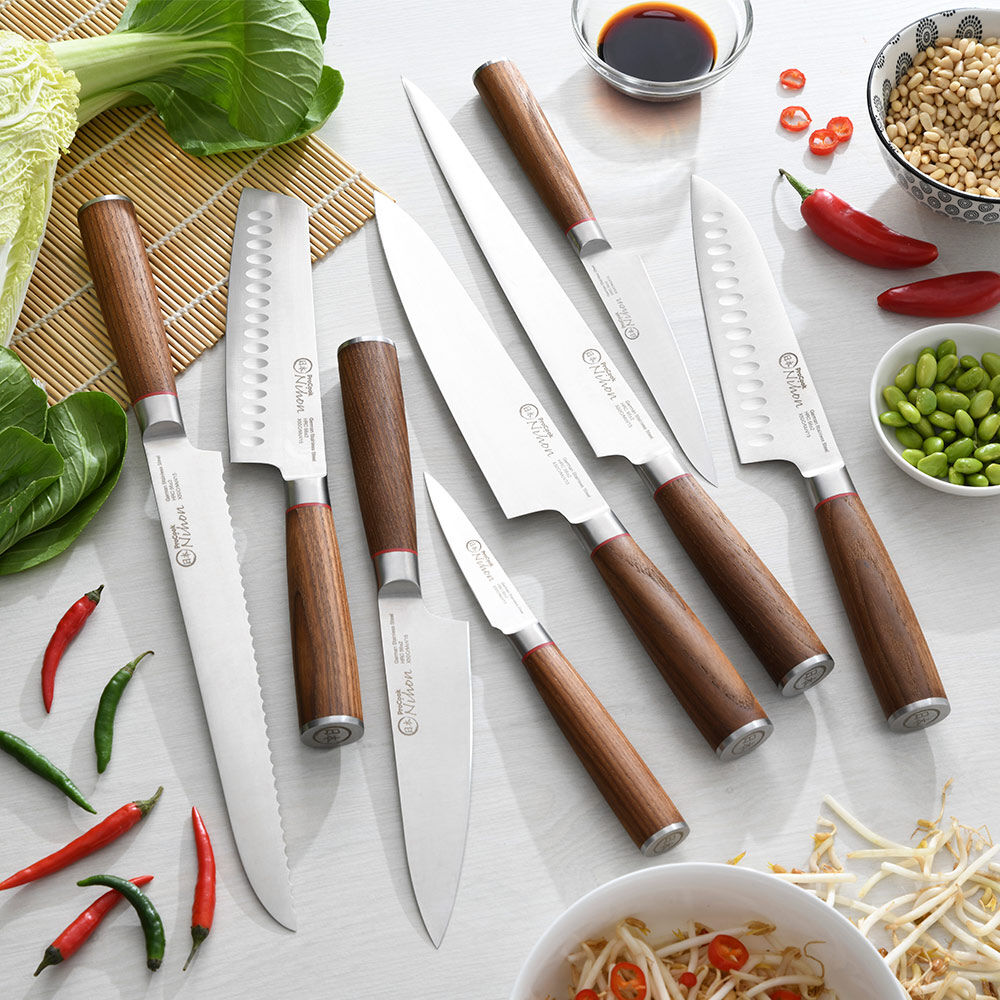
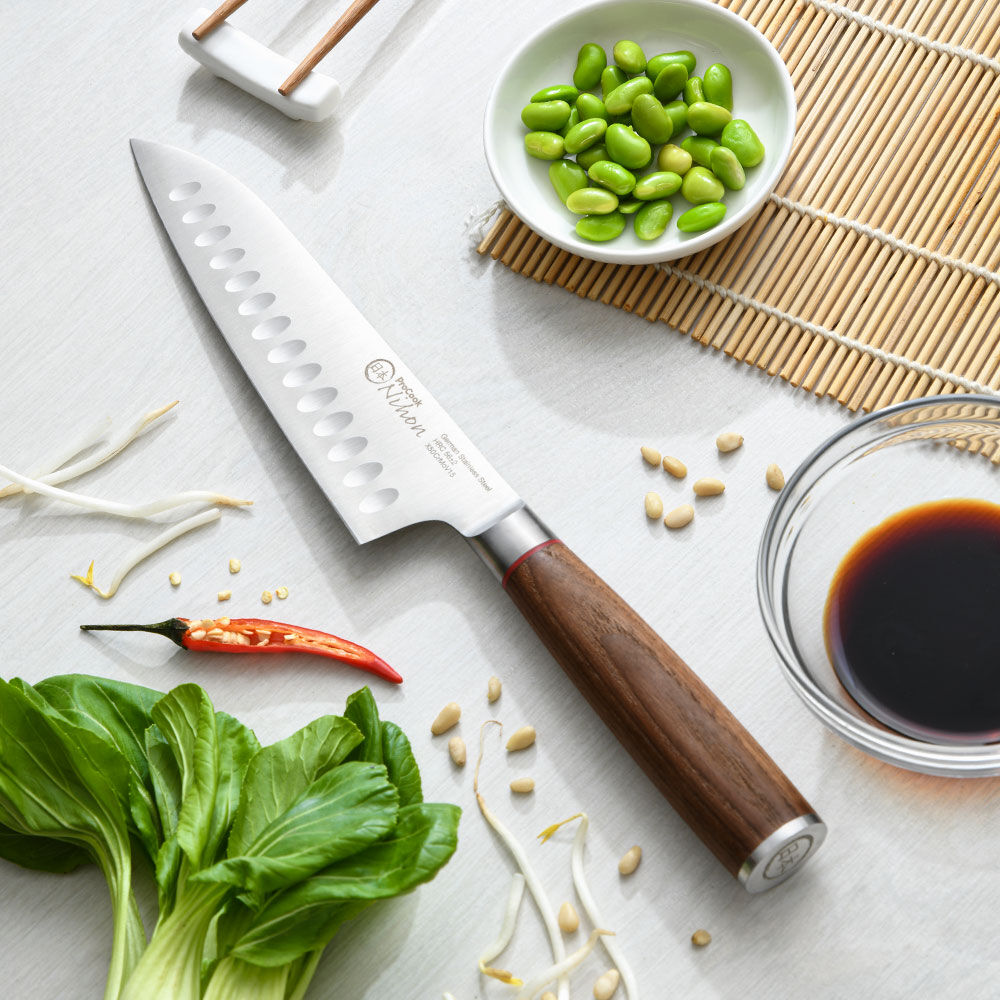


Japanese Knives and Damascus Steel
While not all Japanese knives are crafted from Damascus steel, it is a common steel type due to the numerous advantages it brings to kitchen knives. Damascus steel has been a popular type of steel since the medieval era and is produced by melting iron and steel with charcoal in an environment lacking oxygen. The steel and iron absorb the carbon emitted from the charcoal, resulting in an incredibly sharp blade and its beloved wavy, mottled design that runs through the blade.
Damascus is highly regarded as it is hard and flexible while also maintaining a sharp edge. An edge that stays sharper for longer makes slicing and chopping much easier, enhancing the cooking process.
You might need these:

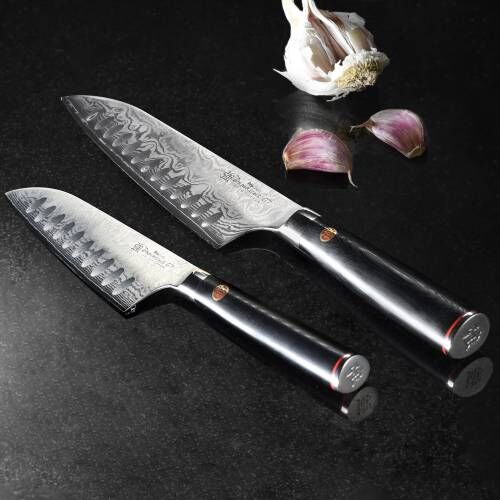
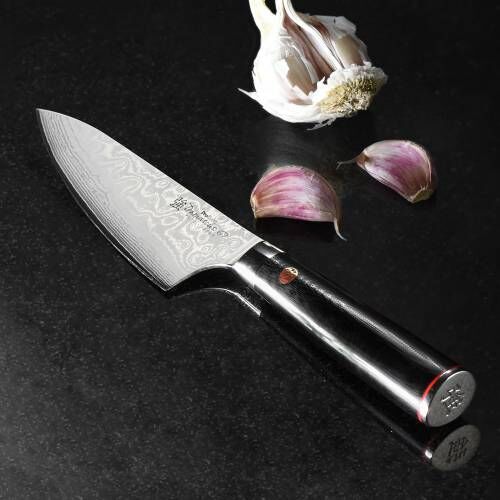
How Do You Take Care of a Japanese Kitchen Knife?
Knife care is vital when it comes to protecting the integrity of your kitchen knives. However, caring for your Japanese kitchen knives may differ from the typical caring tips for more standard knives. Regular sharpening, cleaning and polishing is needed when owning a Japanese knife or Japanese style knife due to the thinner blade associated with Asian and Asian inspired kitchen knives.
How to Wash Your Japanese Knives
Whether you have a standard Western kitchen knife or a Japanese style knife, you should get into the habit of washing off your knife with a damp and slightly soapy cloth or sponge and drying your knife thoroughly, ensuring that there are no water spots left on the blade that can cause corrosion or rust. Not only is rust unappealing, but it can also be dangerous if it comes into contact with food.
Can You Put Japanese Knives in the Dishwasher?
The short answer: no, do not put your Japanese knives in the dishwasher. This is because a dishwasher produces a lot of heat and steam that will expand and warp the metal, damaging the knife's edge. Dishwasher detergent can also be abrasive, damaging the look and integrity of the blade and handle.
Always handwash your kitchen knives and dry them off completely. Do not leave your knife to air dry as this can cause rust to form. Once your knife is dry, place it in adequate knife storage solutions, so that the blade and edge is kept out of harm's way and reduces the risk of any knife-based kitchen accidents.
Our Japanese style knives are handwash only and should not be placed in the dishwasher.
How to Remove Rust from a Japanese Knife
Neglecting your knife can cause rust to form on its blade. Not only is rust unsightly, but it is also dangerous as rust shouldn't encounter food or be ingested. Knowing how to remove rust can restore your knife back to pristine condition.
The correct way to remove rust from a Japanese knife requires you to create a solution of white vinegar (or apple cider vinegar) or a baking soda paste. Place the knife in the solution and allow it to soak for 5 - 10 minutes, and once you are done, wipe down the rusted areas with a soft cloth or sponge. If you're cleaning your knife with a baking soda paste, apply the paste onto the blade and lightly scrub.
If the rusted area is particularly tough to clean, you can use steel wool, but this can cause scratches to appear if you scrub too hard. Rinse your knife and dry the entirety of the blade to stop rust from redeveloping.
How to Cut Food with Your Japanese Knives
Cutting food with a knife is more complex than simply pressing down on the food in question and rocking the blade back and forth. The easiest way to avoid dulling or chipping the blade is to cut straight and avoid twisting. Unless you are using a cleaver or a knife designed to cut through bone, do not use your Japanese knife to cut animal bones or tough meaty areas. Santoku and Nakiri knives should also not be used to cut certain hard foods like coconuts or pineapples.
The surface you cut your food on matters. It is best to use your Japanese knife on a chopping board that isn't too hard and at risk of dulling the blade. We recommend using a plastic or wooden chopping board as they allow your knife to slightly bite into the surface, minimising the risk of the knife's edge being dulled or chipped. The right chopping board can elongate your knife's lifespan.
Japanese Knives and Acidic Foods
It's best to avoid all acidic foods such as tomatoes and lemons, however, this isn't always possible. If you do use your Japanese knives (or any carbon steel knife) to cut through acidic foods, rinse your knife under running water straight after cutting the acidic food and dry the blade for rust prevention.
Certain foods can also cause patina, which is a green, brown or black film that develops on the surface of specific metals. Onions, cabbage, garlic and artichokes are a few examples of foods that can cause patina to arise, so if you do cut these foods, make sure to rinse your knife under running water straight away, stopping patina from developing.
A Japanese knife does not require different storing methods than Western style knives. Rather, you should store your knives in a knife block, safely in a kitchen drawer, on a knife wall rack or in a knife roll.
When storing your knives, make sure that there is no risk of the knives being jostled and developing chips.
How to Store Your Japanese Knives
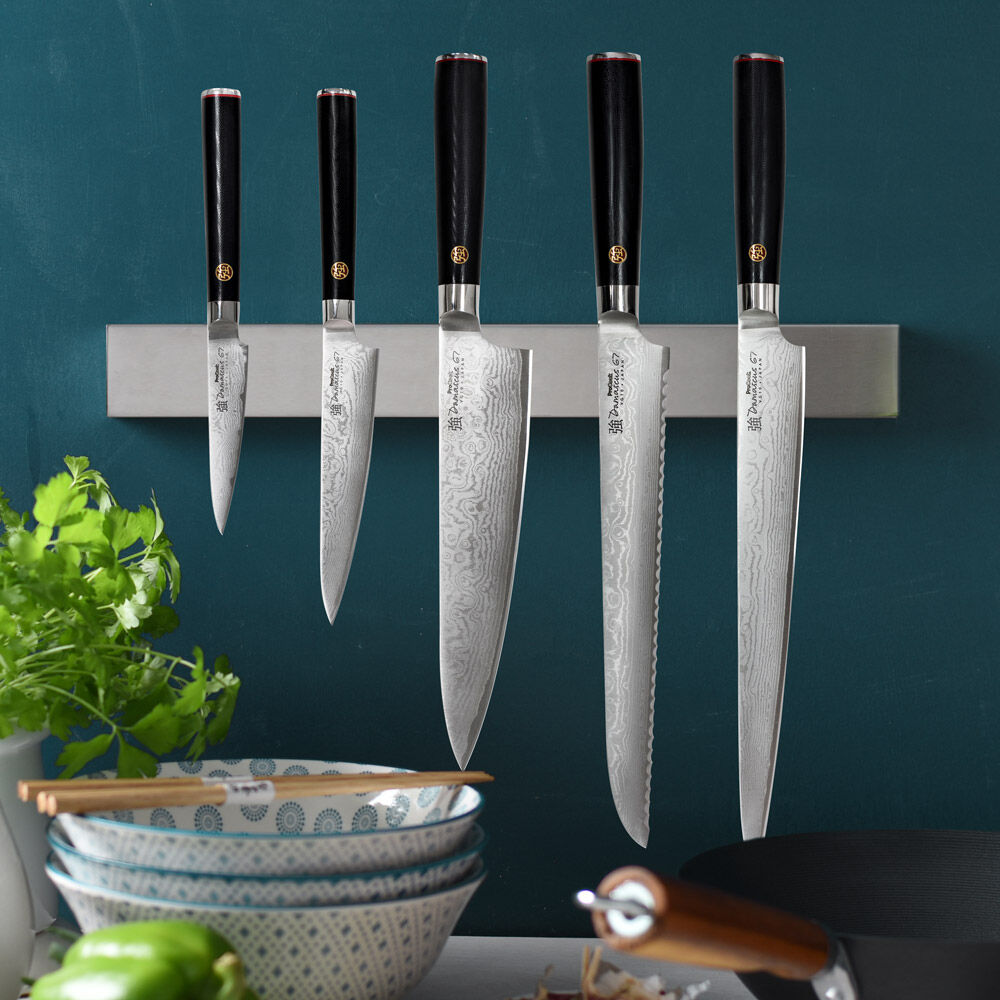
Why are Japanese Knives so Sharp?
Japanese knives and Japanese style knives are much sharper than their German counterparts because the blade is generally made from a harder steel, resulting in an edge that can be cut and sharpened to a much finer angle. Thinner and sharper blades are ideal for thinly slicing food, but they are also more prone to chipping and, therefore, require more maintenance.
How to Sharpen a Japanese Knife
A whetstone is a great sharpening tool as it allows you to hone your knife's edge exactly how you wish. Although electric knife sharpeners have their own benefits, whetstones can increase the lifespan of your knife as they reduce the risk of blunting your knife's edge.
All our Japanese style knives are double bevel for enhanced endurance and durability, while also encompassing a thinner and sharper blade. This double bevel on our Japanese style knives requires sharpening on both sides, much like a standard Western knife.
TIP:
Check out our video on 'How to Use a Whetstone' for advice and guidance on how to sharpen your kitchen knives properly and safely.
What Angle Should I Sharpen my Japanese Knife?
Unless otherwise specified, you should sharpen your Japanese knife at an approximate angle of 10 -15 degrees.
That being said, there is no 'one-size-fits-all' when it comes to a knife's angle, and the angle of your knife not only depends on the manufacturer but also what you are using the knife for. For instance, if you are cutting fish and leafy greens, you would need a sharper angle than if you were using the knife to cut thicker vegetables like a potato.
How Often Should I Sharpen my Japanese Knife?
How often you sharpen your Japanese knife depends on how regularly you use your knife. For knives that are used often, we suggest honing the knife's edge once a week. Always check the individual sharpening requirements that your kitchen knives require.
TIP:
Sharpening a knife on a whetstone takes skill, which is why if you are inexperienced in sharpening your kitchen knife, you may want to invest in a sharpening guide. Our knife sharpening guide is designed to help you angle your knife, so you get the desired edge for easy slicing and dicing. A sharpening guide increases the accuracy and will help you hone the perfect angle for your Japanese style knife.
If you have never sharpened a knife before, or you are worried about damaging the knife's edge, all our in-house staff are trained in knife sharpening. Feel free to visit one of our stores for a tutorial on how to sharpen your kitchen knives properly. We also have a guide dedicated to explaining how to sharpen your kitchen knives properly.
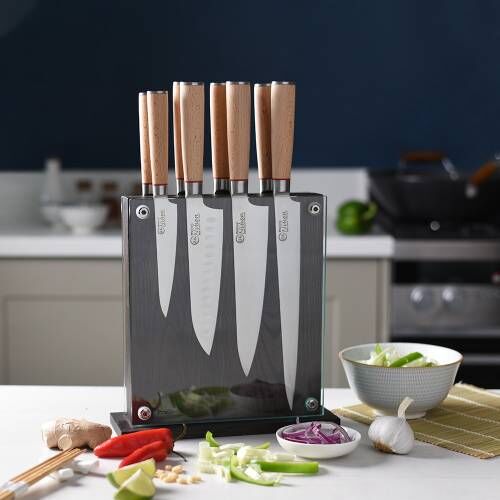
We have two knife ranges inspired by traditional Japanese craftmanship. Both our Japanese style knife ranges, the Nihon X50 and Damascus 67, encompass the precision and super-sharp cutting edge that is common amongst Japanese knives.
Nihon X50
All knives in our Nihon X50 range feature carbon stainless steel blades, a European Beech handle and a rear bolster for perfect balance. The stainless steel used in the Nihon X50 range contains 0.5% carbon for improved edge retention and 15% chrome for enhanced corrosion resistance.
Our Nihon X50 Japanese style knives are as beautiful as they are functional. Not only are our Nihon X50 knives well balanced, but they're comfortable to hold and have a sharp edge for precise slicing. Whether you're a casual home cook or consider yourself a professional chef, our Nihon X50 range is perfect for precision tasks (slicing food into thin, ribbon-like slices).
Damascus 67
Our Damascus 67 range is made from the renowned VG10 Damascus stainless steel and draws inspiration from the traditional knife manufacturing methods used by craftsmen in Echizen, Japan. Each of our Damascus 67 knives features the wavy, mottled pattern associated with Damascus steel and includes a VG10 1% carbon central core for long-lasting cutting edge and unmatched sharpness. The VG10 core is clad with 33 layers of Damascus stainless steel on each side, promoting anti-corrosive properties and resulting in our 67 layered Damascus knife.
All our Damascus 67 knives have an official Rockwell hardness rating (HRC) of 60, which is the optimal hardness for VG10 steel. This Rockwell hardness rating is a testimony of the quality of steel and methods used when crafting our Damascus 67 knives, resulting in knives hard enough to hold an edge but not too brittle to chip.
ProCook's Range of Japanese Style Knives
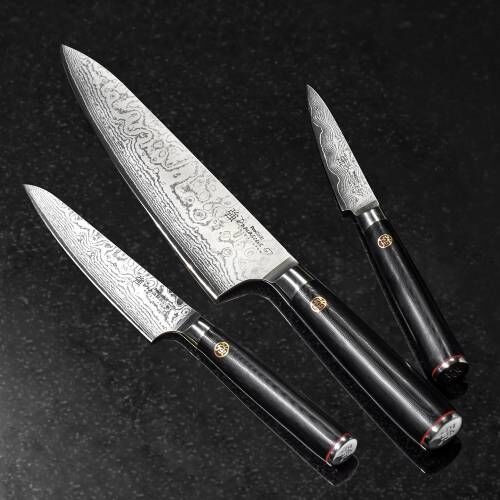
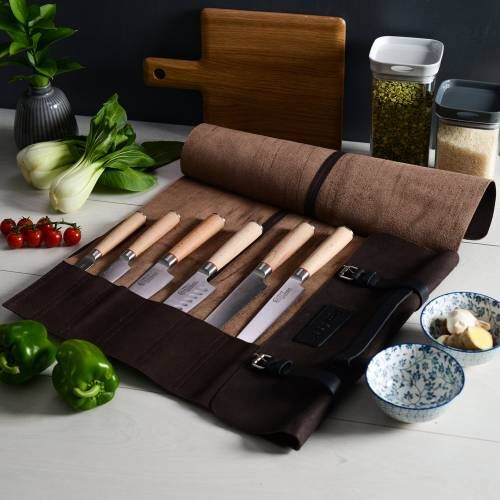
Our 6 piece Nihon X50 Knife Set, presented on our leather knife case.

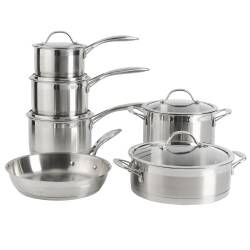
 Electricals
Electricals
 Coffee
Coffee
 Mixers and Blenders
Mixers and Blenders
 Kettles and Toasters
Kettles and Toasters
 Cooking
Cooking
 Small Appliances
Small Appliances
 Cookware & Bakeware
Cookware & Bakeware
 Pots and Pans
Pots and Pans
 Speciality Cookware
Speciality Cookware
 Baking
Baking
 Roasting
Roasting
 Knives
Knives
 Knife Sets
Knife Sets
 Single Knives
Single Knives
 Knife Accessories
Knife Accessories
 Tableware
Tableware
 Dinner Sets
Dinner Sets
 Serveware
Serveware
 Table Accessories
Table Accessories
 Outdoor Dining
Outdoor Dining
 Drinkware
Drinkware
 Hot Drinkware
Hot Drinkware
 Cafetieres and Teapots
Cafetieres and Teapots
 Drink Accessories
Drink Accessories
 Accessories
Accessories
 Kitchen Utensils
Kitchen Utensils
 Tools and Gadgets
Tools and Gadgets
 Storage
Storage
 Cleaning
Cleaning
 Summer Offers
Summer Offers
 Offers
Offers
 Gifting
Gifting

